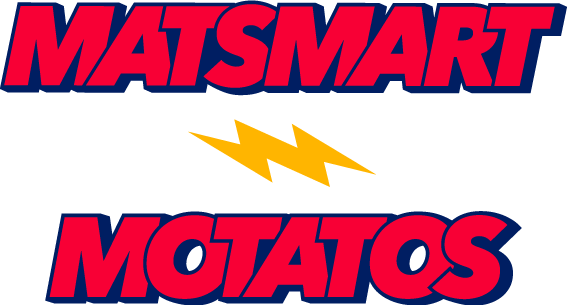
Matsmart runs 11x more experiments within a year and democratizes product analytics

11x
50+
25+
Matsmart-Motatos is an e-commerce company that sells food at a discount, reducing waste by preventing overstocked food and food with packaging errors from being thrown away. Engineering Manager Alessio Maffeis notes that being a 100% online supermarket, tech plays a crucial role in the company.
The search for a modern experimentation and analytics tool
Matsmart’s experimentation efforts were limited prior to Statsig, as it was time-consuming to set up tests and analyze results. Joakim Aglo, their first Product Manager, reflected on the team’s growth over the past four years.
“Running A/B tests used to require a lot of effort. Setting up the experiment in the code took time, which slowed us down. Analyzing the results often meant looking for data in multiple systems, which was sometimes sampled. Everything was just too tedious, which resulted in us running very few experiments.”
This led Matsmart to explore vendors in the market to unify feature flagging, A/B testing, and analytics.
Alessio shared that they ultimately chose Statsig due to the ease of integration and scalable pricing model. “The strong integration with Vercel and being able to run server-side tests effortlessly made us immediately see value. We could easily ingest existing events from Segment and were up and running quickly.”
Feature management becomes efficient and experimentation scales exponentially
There were two main areas where Statsig made an instant impact. Firstly, Alessio noted the improvements in the release process thanks to feature flagging.
“Working with feature flags (gates) was the single biggest positive change in our development workflow. In the past, we heavily relied on feature branches. As our team grew, we had a lot more people working on the same codebase, and having long-lived feature branches increased the chance of conflicts. Now we work in smaller iterations and integrate work in progress changes right in the main branch, behind feature gates”

Alessio Maffeis
Secondly, Joakim shared how the experimentation process became more efficient as best practices were enforced. “Statsig improved how we work with experiments. It makes us do things better – everything from how you set up an experiment, the hypothesis, and metrics. We began thinking in advance about what we wanted to measure.”
“We started making decisions much faster because we defined a hypothesis, set up the experiment in Statsig, and had all the data in one place. We went from running a handful of experiments a year to always having experiments running at any given point.” Over the next 12-18 months, Matsmart’s experimentation velocity exponentially increased, as illustrated below:

Product and Development teams become more customer obsessed
Joakim was pleased to see teams become more product-centric and customer-obsessed thanks to Statsig.
“Just the fact that we can test really fast changed the way people think, and they wanted to take ownership and experiment more. We started looking at data for every product change; not just releasing things for the sake of releasing them but instead checking if people are actually using what we’re building and what the impact is on the relevant metrics.”
Alessio commented on two key aspects of Statsig that enabled the culture to spread quickly across the organization. “Previously we didn’t have data consistency between what we saw in Google Analytics and the Data Warehouse for some events. Thanks to the Segment integration, Statsig enabled us to have consistent data in both platforms – this created trust and made it easier to adopt across the organization. And from a technical perspective, Statsig was very easy for developers to adopt.”
Statsig’s Product Analytics helps democratize data across the company
As the experimentation culture grew, more stakeholders, including non-technical ones, were empowered with data thanks to Statsig’s Product Analytics.
Joakim shared how various team members leverage Statsig to explore data and gather insights to guide their decisions. “Statsig’s Product Analytics has helped both product teams and commercial partners make better decisions on where to focus our efforts to help customers and grow the business.”
Some examples of how teams are using Product Analytics:
- Understanding which product listings (categories, campaign pages, etc.) generate the most add_to_carts
- Identifying areas of the site where users are “opening their wallets” (adding the first product to cart)
- Creating funnels to better understand where users are dropping off.

Alessio Maffeis
Statsig allowed teams to quickly check things on their own without needing to ask for help or use Snowflake or Power BI. Joakim commented, “We’ve been adding more metadata to our events so people can build more comprehensive funnels and dashboards for important metrics.”
“When I get questions from stakeholders in the company, I often create a dashboard or share something in Statsig, which has been a natural way for people to get into the platform. Once you share something that people find useful, they then want to explore it themselves, and that’s how the usage in the company has grown organically.”
Rebuilding the checkout workflow
Matsmart rebuilt their checkout workflow to optimize conversions using data from Product Analytics and subsequently running experiments on Statsig.

Joakim Aglo
Teams were able to analyze how users move through the checkout flow and make various tweaks, such as testing new search engines. “Whenever we change something in checkout, we can see how that impacts funnel metrics. We’ve run a bunch of experiments with really good results.”
“Creating dashboards used to be a big obstacle with event data across systems. Statsig has unlocked self-serve analytics.”
Matsmart also runs many other experiments, aiming to make it easier for users to browse the site and find relevant products. “As always, some experiments show negative results, which is good to know so we can rethink or ditch that idea. But some experiments have shown really good results. Knowing what works and what doesn’t helps us decide where to direct our focus going forward,” Joakim noted.
Now cross-functional teams are empowered to explore data and gather insights swiftly. For example, if someone is interested in knowing which sections of the site users are adding products to cart from, they can easily create a dashboard to visualize this information.
About Matsmart-Motatos
Matsmart-Motatos is a Swedish online grocery company that has been around for 10 years, with presence in Sweden, Finland, Denmark, Austria, and Germany. They specialize in selling pantry items at a discount on a mission to eliminate food waste from overstocking and packaging errors.